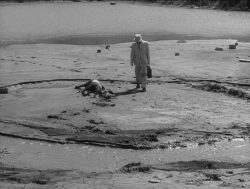October 31st, 2005
One of the offshoot presumptions of a serial feature is that, in subsequence, it generates some amount of suspense — intended or not — and must arrive at some concluding gesture. Thus, the final entry in our 31 Days of Horror serial carries some expected and inevitable importance. And being as last year’s final review cannot be exceeded in terms of appropriate relevance, this year we have honored one of the fundamental tenets of horror, and filled our sequel with more bodies.
Our tastes in horror — as this feature may or may not pronounce — vary greatly, so, in an effort to both educate each other (and to offer our readers an unexpected treat), we have opted to recommend each other films, to either highlight one of our favorites, or to experience something we may not otherwise see. In addition, we’ve each penned an introduction to the film we have recommended.
Films

Funny Games / 30 October
The torment escalates until one in the family is killed, but the film remains decidedly ascetic and self-aware; it’s the viewer’s prosecution, and for him there will be no relief. As a metaphysical experiment in sadism, Funny Games is endorsed by negative responses.

Kissed / 30 October
The film is a patchwork of genres; blending horror, the psychological thriller, and, yes, the romantic comedy, at times slightly discombobulating due to the morbid connecting threads, but ultimately it is an interior journey for a unique sexual deviant, Sandra.

Cat People / 31 October
Female sexuality is a rich source of a certain kind of horror—the kind of horror that plays upon the anxieties that prudish bourgeois men have about their wives’ sex lives. Jacques Tourneur and Val Lewton’s 1942 classic, Cat People, exploits these fears about “ancient sin” and “corrupt passions” while also making use of popular concerns about the “atavism” of Eastern Europe.

Gremlins / 30 October
Joe Dante’s Gremlins is pretty much the quintessential ‘80s movie, and that’s not just because its cast includes Judge Reinhold, Cory Feldman, and Phoebe Cates. Luckily it’s more an emblem of the ‘80s rather than an artifact, but it’s a precarious position considering the film is more famous today as tame TBS programming filler.

The Birds / 30 October
The film features no soundtrack other than the sounds of bird (sometimes electronically manipulated), very little dialogue, and a very small cast. The formal control of this movie is so extreme as to appear diagrammatic. To see one of the scenes mapped out as in Bellour is almost to look at a blueprint.

The Fury / 30 October
The Fury is meant to be a celebratory work, blowing the medium apart at the seams, encouraging the viewer to leave past considerations and expectations at the theatre door. It’s designed to invoke a strong, and strongly confused, reaction, and that really is the point.

The Stepfather / 30 October
Given that the film was released in 1987, it is tempting to view Jerry as someone who took Ronald Reagan’s much-touted ideas about family values and ran a little too far with them. At the same time, The Stepfather openly feeds on the paranoia of a generation of teenagers who increasingly found themselves having to confront divorce and stepparents.





